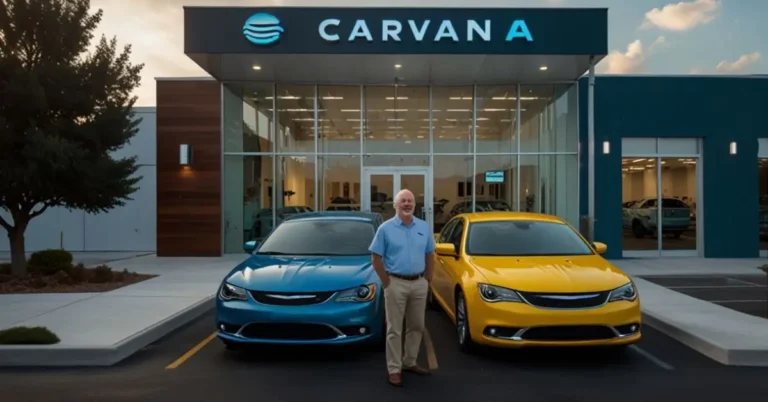In a groundbreaking move, Carvana acquires Jerry Seiner Chrysler, marking its first foray into the new-car dealership arena. This acquisition signifies a pivotal shift for the e-commerce giant, traditionally known for its online used car sales. By integrating a physical dealership into its business model, Carvana aims to blend digital convenience with traditional car-buying experiences.
Carvana’s Evolution: From Online Retailer to Franchise Owner
Established in 2012, Carvana revolutionized the car-buying process with its online platform and iconic car vending machines. The company’s acquisition of Jerry Seiner Chrysler Dodge Jeep Ram in Casa Grande, Arizona, represents a strategic expansion into the new-car market. This move allows Carvana to offer a broader range of vehicles, including new models from Chrysler, Dodge, Jeep, and Ram.
The Significance of Acquiring Jerry Seiner Chrysler
The decision to acquire Jerry Seiner Chrysler is not merely about expanding inventory. It reflects Carvana’s intent to enhance customer experience by providing options for both new and used vehicles. The dealership, located approximately 45 miles south of Carvana’s Tempe headquarters, will be rebranded as Casa Grande CDJR. Importantly, all 41 employees will be retained, ensuring continuity and local expertise.
Strategic Implications for Carvana
Diversification of Offerings
By entering the new-car market, Carvana diversifies its product offerings, appealing to a wider customer base. This move positions the company to compete more effectively with traditional dealerships and other online platforms.
Enhanced Customer Trust
Operating a physical dealership can bolster customer trust, especially among buyers hesitant to purchase vehicles entirely online. The tangible presence provides an opportunity for customers to experience vehicles firsthand before making a purchase.
Operational Synergies
Integrating a brick-and-mortar dealership allows Carvana to streamline operations, from inventory management to customer service. This synergy can lead to improved efficiency and cost savings over time.
Industry Context: A Comparison with CarMax
Carvana’s move mirrors CarMax’s earlier strategy, where the company operated new-car franchises before focusing solely on used vehicles. While CarMax eventually exited the new-car market, Carvana’s approach suggests a hybrid model, combining online convenience with physical dealership benefits.
Comparison Chart: Carvana vs. Traditional Dealerships
| Feature | Carvana (Post-Acquisition) | Traditional Dealerships |
|---|---|---|
| Sales Channels | Online & Physical | Primarily Physical |
| Vehicle Offerings | New & Used | New & Used |
| Customer Experience | Digital-first | In-person |
| Inventory Management | Centralized | Decentralized |
| Pricing Transparency | High | Variable |
| Test Drive Availability | Limited | Extensive |
| Financing Options | Online & In-house | In-house |
Future Outlook
Carvana’s acquisition of Jerry Seiner Chrysler could signal a broader trend of online retailers integrating physical locations to enhance customer experience. If successful, this model may prompt other e-commerce platforms to explore similar expansions, potentially reshaping the automotive retail landscape.
Conclusion
The fact that Carvana acquires Jerry Seiner Chrysler underscores a strategic pivot towards a more integrated retail approach. By combining its digital prowess with a physical dealership, Carvana aims to offer a comprehensive car-buying experience. This move not only diversifies its offerings but also positions the company to better meet evolving consumer preferences in the automotive market.
FAQ’s
1. Why did Carvana acquire Jerry Seiner Chrysler?
To expand into the new-car market and enhance its product offerings by integrating a physical dealership.
2. Will Carvana continue operating the dealership under the same name?
The dealership will be rebranded as Casa Grande CDJR, aligning with Carvana’s branding strategy.
3. How does this acquisition benefit Carvana customers?
Customers gain access to new vehicle options and the ability to experience cars in person before purchasing.
4. Does this mean Carvana is moving away from online sales?
No, Carvana continues to prioritize its online platform while integrating physical locations to enhance customer experience.
5. How does this move compare to CarMax’s strategy?
While CarMax eventually focused solely on used cars, Carvana is adopting a hybrid model, offering both new and used vehicles through online and physical channels.
6. What impact could this have on the automotive retail industry?
If successful, Carvana’s model may influence other online retailers to incorporate physical dealerships, potentially transforming the industry.

